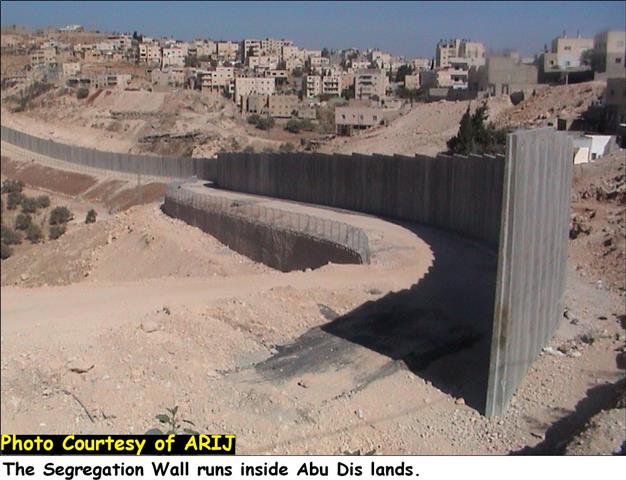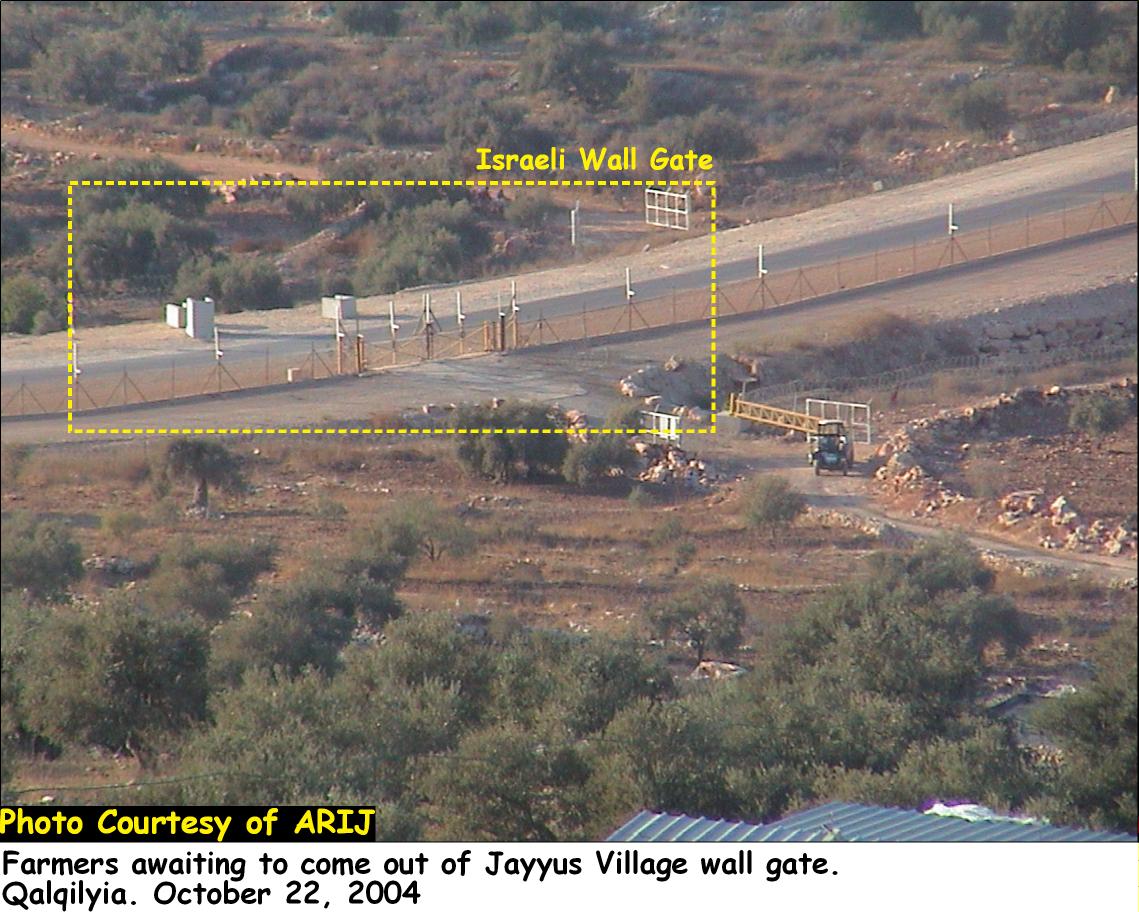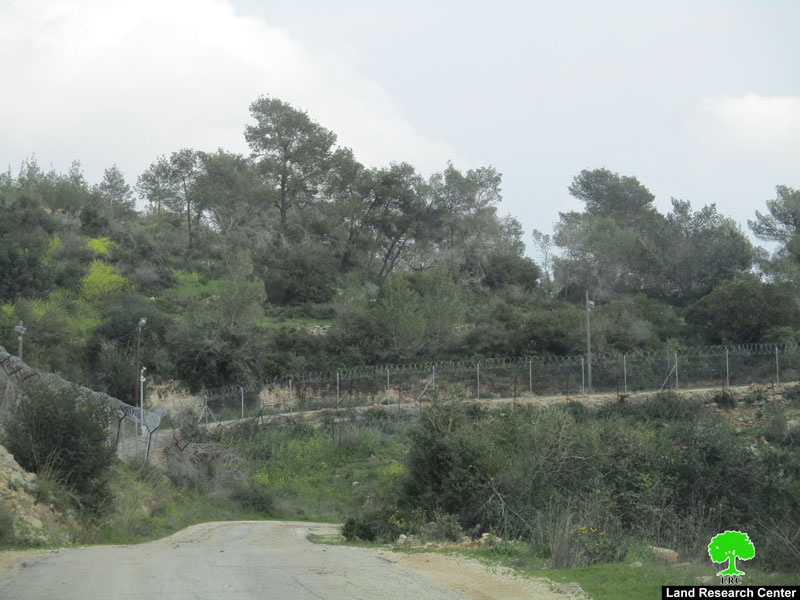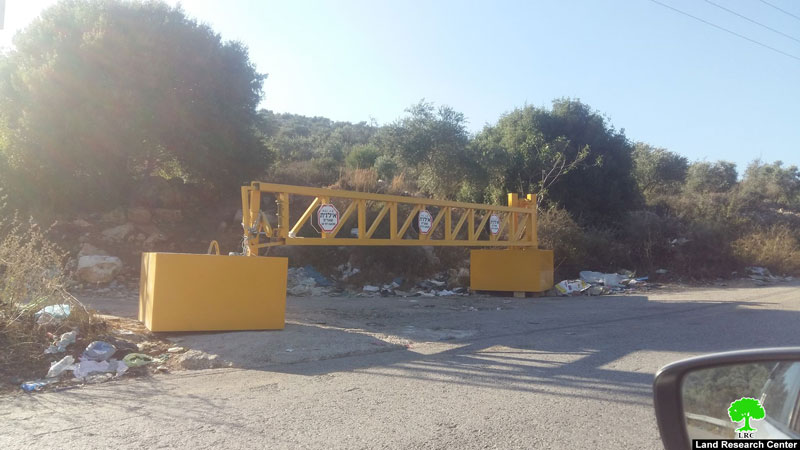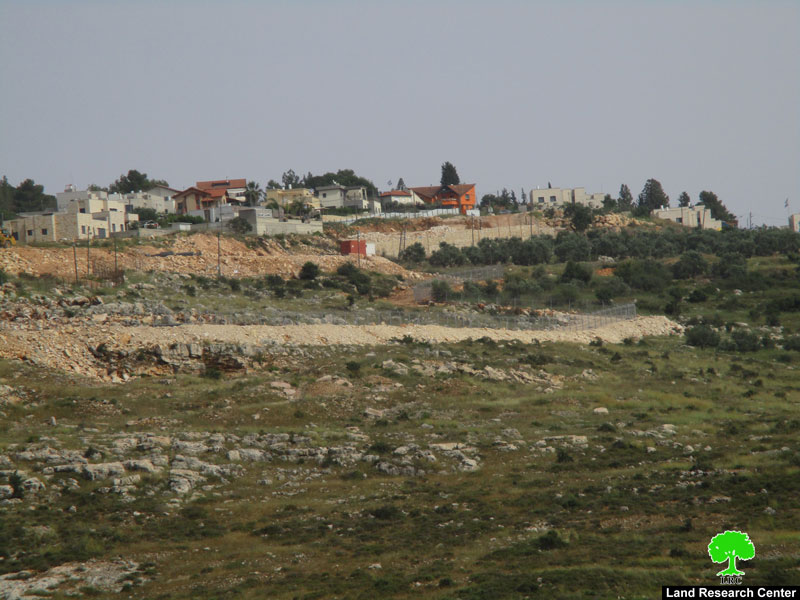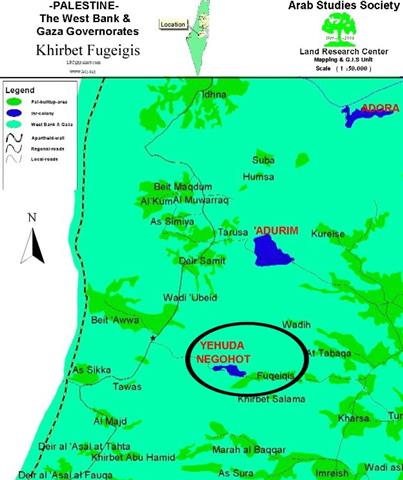'A Live tragedy and endless Suffering '
In June 2002, the Israeli government began to build a Segregation Wall on the Palestinian lands in the West Bank and Gaza Strip. Israeli authorities justify the project under the pretext of 'security concerns.' Far from guaranteeing security for Israel or its population, however, the Wall has the effect of extending Israeli territorial authority over large expanses of Palestinian land in the Occupied Palestinian Territories (OPT). The Segregation Wall runs inside the West Bank and Gaza Strip and separates Palestinian communities from their lands and neighboring towns and villages, creating large 'Segregation Zones' on the western and eastern flanks of the West Bank. Construction of the Wall began in the northern West Bank and parts of the Gaza Strip. It now winds through much of the West Bank's western flank and encircles all of the illegal Jewish settlements in the Gaza Strip. Currently, construction of the Wall continues at a feverish pace as additional areas of Palestinian land are appropriated on a daily basis. See Photo 1 & Photo 2 &
Israel's military apparatus is responsible for planning both the route and the form of the Segregation Wall and humanitarian concerns have been granted only nominal importance. Vast areas of Palestinian lands have been confiscated, thousands of trees uprooted, hundreds of dunums of agricultural lands razed, and tens of wells appropriated or demolished. Significant portions of the Palestinian areas cut-off by the Wall have also been declared closed military areas and off-limits to Palestinians. As a result of these drastic affects, thousands of residents inside the West Bank and Gaza Strip have been severely affected socially, economically and politically.
In addition to the series of Walls in the Gaza Strip, the first phase of the Israeli Segregation Wall in the West Bank was completed between 2002 and 2003. The second phase is currently ongoing and the third phase is planned to begin shortly. The entire structure is scheduled to be completed by the end of 2005.
Phase one of the Segregation Wall started in June 2002 and was completed in July 2003. The first phase runs along the northwestern part of the West Bank and stretches over 123.3 km from the village of Salem located on the northern border of the West Bank to the village of Mas'ha and the neighboring illegal Israeli settlement of Elkana located on Palestinian lands within the governorate of Salfit. The vast majority of the structure is built on confiscated Palestinian territory east of the Green Line (the internationally recognized border between Israel and the West Bank). As part of this phase, construction also began in the so called '' Jerusalem Envelope '' and work took place in the southern Ramallah District, the northern Bethlehem District and East Jerusalem. (See map of Jerusalem envelope). ). As part of this phase, construction also began in the so called '' Jerusalem Envelope '' and work took place in the southern Ramallah District, the northern Bethlehem District and East Jerusalem. ()
Phase Two: began in March 2003 and is currently ongoing. Construction for the second phase is focused in the northeastern region of the West Bank, from the village of Salim to the Jordan Valley; the central region, including a section from the illegal Elkana settlement to the illegal Ofer settlement; the western Bethlehem section from the illegal Har Gilo settlement to the illegal Carmel settlement; and especially, in Palestinian East Jerusalem and the ''Jerusalem Envelope'' When complete, phase two will stretch over 475.5 km. '' When complete, phase two will stretch over 475.5 km.
Phase Three: According to various Israeli projections, the remainder of the Segregation Wall is scheduled for completion by the end of 2005. The final phase will cut through large sections of Palestinian land in the south of the West Bank, and cut closely around and inside Hebron city. Other sections of the wall will be completed in other areas of the West Bank, cutting off access to regions already affected by the Wall and ghettoizing additional Palestinian communities. The third phase will also cut deeper into the eastern section of the West Bank. This 'Segregation Zone' will include most of the Jordan River Valley and the Dead Sea region and will be under complete Israeli control.
Negative impacts of the Wall on Palestinian communities
1- Agricultural Impact:-
The Israeli Segregation Wall affects all Palestinian lands near the Green Line and many lands deeper inside the West Bank and Gaza Strip where the Wall cuts well inside Palestinian territory. By virtue of its winding route, the Wall extends direct Israeli control over ever larger portions of the OPT. In the West Bank alone, the Segregation Wall will confiscate 2471.82 km2 of Palestinian land, much of it cultivated.
Map 2: Olive groves threatened by the construction of the Segregation Wall. .
Click here for related article
An additional, 224.87 km2 of agricultural lands were razed to construct phase one of the wall in the West Bank. The main Segregation Wall in the West Bank has isolated or endangers at least 832.82 km2 of Palestinian lands (14.2% of the total area). At least, 81 km2 of Palestinian built up areas will be entirely surrounded by the wall and isolated inside ghettos. In addition, the Israeli controlled Segregation Zone in the East of the West Bank will cut off approximately 1639 km2 (28% of the West Bank). Thus, a total area of 2471.82 km2 (over 48% of the West Bank) is in danger of being confiscated and separated from the West Bank by the Segregation Wall.
In the Gaza Strip, more than 20% of the agricultural land has been razed, mostly in order to clear areas for the construction of the Wall and for highly militarized 'buffer zones.' An additional 40% of the territory is isolated by the Segregation Wall and off-limits to Palestinians. Several areas in Gaza have also been completely surrounded and turned into tiny ethnic Palestinian ghettos. The fate of these ghettos and Segregation Zones is particularly drastic. click here for related article
The Segregation Wall in the West Bank and Gaza Strip is not only appropriating Palestinian lands but also enclosing, isolating and threatening Palestinian water wells and springs. The following table shows the number of artesian wells and springs isolated and threatened by the Israeli Segregation Wall in northern sections of the West Bank affected by the first and second phases of construction (see table 1).
Table 1:number of Water wells enclosed and threatened by the Segregation Wall
|
Number |
Annual discharge |
Reason |
|
31 Artesian wells |
3.6 MCM (16% of the Palestinian share). |
Isolated to the West of the Segregation Wall. |
|
53 Wells |
8.8 MCM |
Enclosed by the Segregation Wall. |
|
21 Wells |
3.1 MCM |
Threatened by the Segregation Wall. |
|
16 Springs |
0.2 MCM |
Enclosed by the Segregation Wall. |
|
25 Springs |
62.0MCM |
Isolated by the Segregation Wall. |
MCM- Million Cubic Meters.
Source: Applied Research Institute – Jerusalem (ARIJ).
In eastern sections of the West Bank there are 105 artesian wells and 30 springs used by Palestinian communities. The annual discharge from these wells and springs reaches between 22.9 and 40.0 MCM. Construction of the Segregation Wall and enclosing of the Segregation Zone in the Jordan Valley will thus cut off many more Palestinians from their water supplies and wells, exacerbating the water problem in many Palestinian localities and making the irrigation of crops nearly impossible. The resulting impacts on Palestinian agriculture will be enormous. The Israeli Segregation Wall has also increased the difficulty of transporting goods and products to market. In many areas, specifically within the West Bank and Gaza Strip Segregation Zones, Israeli occupying forces prevent farmers from transferring produce out of the immediate area to the larger markets in neighboring urban centers. Moreover, the Segregation Wall has greatly increased the susceptibility of many native terrestrial herbs in the hills and valleys of the West Bank. Herbs such as terrestrial Frisian Thyme are threatened with local eradication, or even extinction, because of the environmental destruction resulting from the construction and maintenance of the Segregation Wall.
Assault on the Jordan Valley, October 2003.
Israel Isolates the Northeastern Sector of the West Bank, October 2004.
2- Social Impact:-
The Israeli Segregation Wall cuts off many Palestinian communities and villages from neighboring towns and cities. Individuals living in Segregation Zones or newly created ethnic Palestinian ghettos are separated from friends and relations living in nearby villages. Residents of the ghettos are required to obtain permits from Israeli occupation authorities simply to access their homes. Non-residents are restricted from entering these areas. Additional Palestinian communities have been isolated from their agricultural lands which lie on the opposite side of the Wall. As a result, the construction of the Segregation Wall will significantly impair the ability of many Palestinian the families to earn their living. (The full extent of the Segregation Wall – conditions imposed on Palestinian communities as a result of the Wall)
As a result of the first phase of construction in northern regions of the West Bank, 15 villages (including approximately 14,000 people) were isolated between the fence and the Green Line. Another 15 villages, with approximately 140,000 people, are expected to be isolated as a result of the Wall's second and third phases. For example, in the Bethlehem District alone, five villages will be isolated west of the Segregation Wall while another three will be enclosed by the Wall and sealed into enclaves. These villages, and others like them, comprise newly created ethnic Palestinian ghettos, surrounded by the Wall, and facing isolation and extremely difficult economic and social conditions.
3- Impact on Education:-
The Israeli Segregation Wall will also affect the educational system in the West Bank; according to the Palestinian Central Bureau of Statistic (PCBS) 26% of Palestinian students will lose their rights and access to proper education and 81% of Palestinians in regions affected by the Wall will be forced to find alternative routes to their schools and universities as a result of the Wall. An additional 350 schools will be isolated outside the Wall. Residents of the isolated and ghettoized communities will only be able to enter and leave the immediate area through constantly supervised illegal Israeli checkpoints manned by Israeli occupying forces. Israeli soldiers at the checkpoints engage in systematic and sustained acts of harassment and humiliation, making travel physically and psychologically damaging for Palestinian civilians.
4- Economic Impact:-
The Wall has had certain, significant and highly destructive impacts on the Palestinian economy in the West Bank and Gaza Strip. According to the Palestinian Central Bureau of Statistics, the unemployment rate in the Palestinian Territories has climbed to nearly 33%. The World Bank clarifies that some 47% of Palestinians live below the poverty line. Many of the effects are due to harsh Israeli restrictions on trade and humanitarian aid. The Segregation Wall has also had a significant impact, however, mostly in the agricultural sector. Many Palestinians depend on agriculture for their livelihood. According to the Palestinian Ministry of Agriculture, the number of olive trees uprooted as a direct result of the Israeli Segregation Wall surpasses 45,000. The number of olive trees uprooted from the beginning of the Intifada in September 2000 until June 2004 is 144,463, and many more trees are currently threatened. Table 3 shows the number of uprooted trees by area:
| Uprooted OliveTrees by the Israeli Army September 2000 – June 2004 | ||
| West BankDistrict | Uprooted OliveTrees | Value in USDollar |
| Jenin | 12664 | 1872900 |
| Tubas | 1176 | 83610 |
| Tulkarem | 12099 | 1192350 |
| Nablus | 39419 | 1398135 |
| Qalqilya | 10383 | 2214480 |
| Salfit | 14755 | 726900 |
| Ramallah | 12777 | 2501200 |
| Jericho | 30 | 6000 |
| Jerusalem | 2751 | 275100 |
| Bethlehem | 19843 | 5065750 |
| Hebron | 17425 | 1196007 |
| Dura | 1141 | 222250 |
| West BankTotal | 144463 | 16754682 |
Source: Palestinian Ministry of Agriculture.
When the Wall is completed, nearly 3,000 km.2 of Palestinian land will be isolated outside the Wall, cut off from the Palestinian communities that cultivate it, and appropriated by Israeli occupation authorities. Significant portions of land are already isolated by the completed sections of the Wall. Israeli occupation authorities require all Palestinian farmers to obtain special permits to access their lands through military gates in the Wall. In order to obtain the permits, Palestinian farmers must display specific documents signifying ownership of the land. If such documents are not available, Palestinian families are unable to reach their land and harvest their crops. Even individuals who possess the required documents are often denied permits, or granted permits only for very specific, short periods. Israeli occupation authorities also often deny permits, citing 'security concerns.' These arguments are never elaborated upon or explained. In addition, Israeli occupying forces only open the gates at certain periods. Many of the functioning gates in the Qalqiliya District in the West Bank, for example, are only open twice a day for half an hour in the morning and half an hour in the afternoon.
These regulations have severely affected the ability of many Palestinian farmers to support themselves and their families. As an agricultural society, many Palestinians depend on agriculture for their primary source of income. Israel's massive appropriation of Palestinian land and water resources that has resulted from the construction of the Segregation Wall has severely impacted Palestinian society. Farmers have experienced great difficulties in harvesting produce and transferring that produce through gates in the Wall to markets in the interior of the West Bank or Gaza Strip. Merchants have faced similar troubles in transporting commodities to and from Palestinian communities isolated by the Wall. These severe economic conditions promise to persist and worsen as more communities are affected by the Segregation Wall. See Photo 5
In addition to the destruction and appropriation of agricultural land, Palestinian industry has also been greatly damaged as a result of the Segregation Wall. In land clearing operations associated with the construction of the Wall, 8,724 Palestinian industrial installations and factories have been destroyed by Israeli occupying forces. This assault on the Palestinian economy has accelerated an already desperate situation in the OPT. According to the World Bank, from 1999 to 2002 the real gross national income in the OPT declined by 38%. The World Bank also found that 67.6% of the Palestinian population lives below the poverty line on less than two dollars per day. Since September 2000, the number of poor in Palestine has tripled to over 2 million, and 60% of households have lost more than half of their income. As a result, over half a million Palestinians are now completely dependent on food aid.
5- Impact on Healthcare:-
The Segregation Wall has significant and harsh health impacts for Palestinians in the OPT. The isolation and disintegration wrought by the Wall, together with the discriminatory Israeli checkpoint and permit systems, pose a systemic challenge to local and national health care services in the OPT. When complete, the Wall will make it much more difficult for Palestinians to reach hospitals and medical centers situated in nearby cities. Access will be controlled by Israeli occupying forces and based on the Israeli permit system. According to the Health, Development, Information, and Policy Institute (HDIP), the Wall currently adversely affects access to health care for 583,660 Palestinians, including 19,260 elderly, more than 250,000 children under the age of five (who need periodic vaccinations), 33,268 chronic patients and 17,510 disabled people (needing specialized healthcare). These numbers promise to increase as construction of the wall continues, reaching more Palestinian communities. Moreover, according to the International Press Center, 30.6% of medical staff is unable to reach the health centers and hospitals in which they work as a result of the Wall. See Photo 6 & Photo 7 & See Photo 8
Conclusion:-
The most severe impact of the Israeli Segregation Wall is the isolation of huge parts of Palestinian land in the Segregation Zones between the Wall and the Green Line. Combined with the Segregation Zone in the Jordan Valley and the Gaza Strip, these areas comprise almost 50% of Palestinian land in the OPT. Even the land-owners in these areas must apply for permits from the Israeli occupation authorities in order to access their land. The permits can be denied without reason, leaving Palestinian communities almost completely without land or the agricultural products that land produces. As a result, Israel is using the Wall to appropriate nearly 50% of the West Bank and Gaza Strip prima facie. Despite Israel's statements that the Segregation Wall is meant for defensive purposes, the Wall does not follow the route of the green line, the internationally recognized border between the West Bank and Israel. Instead, the Wall cuts deep into occupied Palestinian territory in the West Bank and Gaza Strip, isolating many thousands of Palestinians from the remains of the OPT, creating small ethnic ghettos completely surrounded by walls and fences, and appropriating large tracts of Palestinian land.
Article 53 of the Fourth Geneva Convention of 1949 forbids 'the destruction of real or private property excluding where such destruction is rendered completely necessary by military operations.'' The official commentary to the Convention interprets the stated exception in Article 53 to mean that ''the occupying forces may therefore undertake the total or partial destruction of certain private or public property in the occupied territory when imperative military requirements so demand. '' The core of Article 53 of the convention which originates in Article 23 and Article 46 as well as the prohibition of collective penalties in Article 50 of the Hague Regulation are rules of customary international law. The Israeli Segregation Wall, however, does not meet the standards of military necessity. The extreme damage inflicted on the Palestinian society and economy as a result of the Wall violates the basic laws of proportionality which govern the rules of military necessity.
In addition, Article 147 of the Fourth Geneva Convention states that the 'extensive destruction and appropriation of property' by an occupying force is to be considered a 'grave breach' of the Convention and is defined as a 'war crime.' As a result, Israel's use of the Segregation Wall to appropriate increasing amounts of Palestinian land in the West Bank and Gaza Strip, compromises the feasibility of the military necessity argument and encourages the application of the War Crimes Statute. A thorough analysis of international law, specifically the Fourth Geneva Convention clearly suggests that the Segregation Wall is a war crime and the Israeli occupation authorities responsible for the planning and construction of the Wall should be tried in an international court of law.
Source:-
-
Applied Research Institute- Jerusalem ( ARIJ )
-
Health, Development, Information, and Policy Institute (HDIP)
-
International Press Center
-
Palestinian Ministry of Agriculture
-
Palestinian Central Bureau of Statistics (PCBS)
-
Palestinian Environmental NGO Network (PENGON) Stop the Wall Campaign
[1] One dunum equals 1,000 square meters or 1/4 acre.
Prepared by:
The Applied Research Institute – Jerusalem


